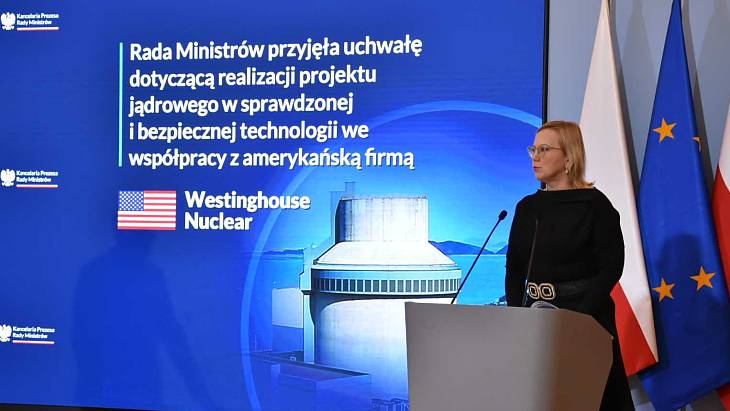News that Westinghouse had been chosen for the first of the Polish government's 6 to 9 GW nuclear project, was revealed on Friday by Prime Minister Mateusz Morawiecki, but was subject to approval by the government, which came on Wednesday.
The resolution that was passed was for a nuclear power plant to be built in northern Poland with a capacity of 3750 MWe, based on AP1000 technology, with the first block built by 2033. It also added that: "Immediate measures will also be taken to prepare and implement the construction of the second large-scale nuclear power plant in Poland."
The resolution says: "The need for permanent independence from energy supplies and energy carriers from Russia is associated with the need to accelerate the implementation of investments in the construction of the first nuclear power plant in Poland. This is an important step in building our country's energy security. The nuclear power plant construction programme is one of the key challenges in the Polish energy sector in the coming years. The implementation of the nuclear project will be carried out in cooperation with the government of the United States of America."
The technology for the second large-scale nuclear power plant has not yet been indicated, with Anna Moskwa, Environment Minister, saying "we remain open to cooperation with European and global industry, also in the context of building a second nuclear power plant in our country".
She added: "The decision to confirm the strategic partnership with the US brings us closer to the implementation of this project … the implementation of this strategic project, and the proper provision of financing for the construction of large-scale nuclear power plants in Poland will enable the reduction of electricity prices while taking into account the interests of end users."
US Ambassador to Poland Mark Brzezinski said: "I am grateful for the leadership that Prime Minister Morawiecki showed by overseeing the selection of Westinghouse for this historic project. Today, Poland is investing in a clean and secure energy future for all of the Polish people."
Patrick Fragman, Westinghouse president and CEO, said: "We are honoured to partner with the Polish government on the launch of a new era of energy security, one that will bring reliable, affordable carbon-free electricity and economic benefits to the people of Poland. This project will create thousands of jobs during construction and for many decades of operation of the plants."
In September last year, it was announced that six large pressurised water reactors with a combined installed capacity of 6-9 GWe could be built by 2040 as part of Poland's plan to reduce its reliance on coal. According to the adopted schedule, the construction of the first nuclear power plant in Poland will start in 2026, with the first reactor, with a capacity of 1-1.6 GWe, being commissioned in 2033. Subsequent units will be implemented every 2-3 years.
Westinghouse signed memorandums of understanding with 22 companies in Poland in September for cooperation on construction of AP1000 reactors in the country and, potentially, elsewhere in Central Europe. The company said it was looking to engage "on a broad scale both the US and European supply chains on this exceptional project, in order to build a fleet of AP1000 reactors in the region".
Westinghouse faced competition to be selected for Poland's nuclear programme from South Korea's KHNP and France's EDF. Its AP1000 is a Generation III+ reactor with fully passive safety systems. Two units are being built at Vogtle in the US, four are operating in China and four are under construction with two more ordered. There are also plans for nine units in Ukraine and, Westinghouse said, it "is under consideration at multiple other sites in Central and Eastern Europe, the UK and in the USA".
In a separate development on Monday this week, South Korea's energy ministry said Poland's ZE PAK, PGE (Polska Grupa Energetyczna) and Korea Hydro & Nuclear Power had signed a letter of intent to cooperate on a nuclear power plant project in Patnow, Poland, assessing the viability of building South Korean APR1400 reactors on the site.





_18570.jpg)
_16159.jpg)
_18938.jpg)
_33584.jpg)





